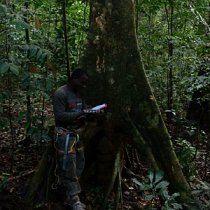
Davy Ulrich Ikabanga
Genetic, ecology and taxonomy of tree species in tropical forests of Africa – The case of the species complex Santiria trimera (Burseraceae)
<p>Species delimitation is a recurrent problem in high diversity ecosystems. For example, <em>Santiria trimera</em> is an African rain forest tree displaying substantial morphological variation (e.g. presence/absence of stilt roots, large or small leaflets, red or green immature fruits). Different morphotypes are found in sympatry in several areas of Central Africa. Despite this variability, only one species is taxonomically recognized. However, a recent study combining phylogenetic data and morphological traits suggest that at least two species should be distinguished. The present study combines morphological traits with population genetics data to realize a taxonomic revision of the African genus <em>Santiria</em> supervised by genetic data. To this end, new herbarium samples were collected in Gabon and Cameroon and are being genotyped using nuclear microsatellite markers. Preliminary data indicate that three different gene pools occur in sympatry and can be distinguished using new diagnostic morphological traits. Our results also indicate that no gene flow occurs between these gene pools, so that three species, currently included in the taxon <em>Santiria trimera</em>, should be distinguished. A reexamination of the major herbarium collections will be performed to complete the taxonomic revision.</p>